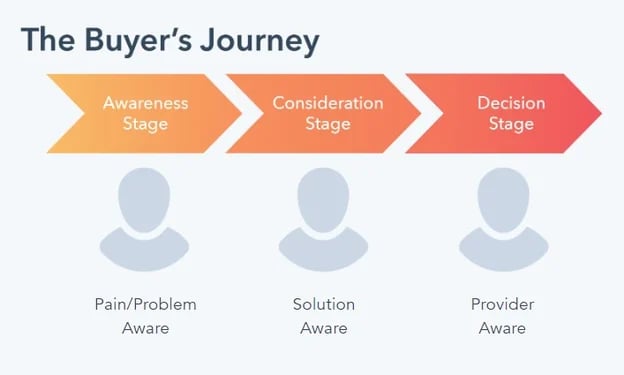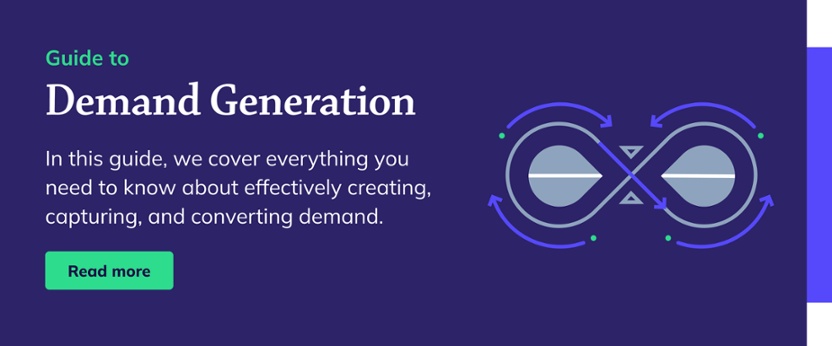Inbound demand generation and inbound marketing are related concepts but have some broad differences in their strategies. In this blog, we break down how the methodologies differ and why inbound demand generation is the preferable strategy for converting today's buyers.
What is inbound demand generation?
Inbound demand generation is a marketing methodology that uses the inbound philosophy with the goal of creating revenue and pipeline. It focuses on both creating and capturing demand, primarily using ungated content to attract, engage, and convert buyers.
Unlike inbound marketing, inbound demand generation recognises that only a small percentage of your buyers will be actively seeking a solution at any given time. So the approach aims to also create demand for the remaining 95% of your market that isn't actively looking for a solution.
When it comes to your website, inbound demand generation is focused on providing an exceptional user experience with the goal of converting high-intent leads. That's people who have submitted a form, explicitly declaring interest in your offering.
Popular tactics used within inbound demand generation include:
- Social media marketing
- Podcasting
- Blogging
- Community building
- Live events
Metrics to measure inbound demand generation success include:
- MQLS (high-intent)
- Marketing generated pipeline
- Marketing generated revenue
What is inbound marketing?
Inbound marketing is a concept that was coined by HubSpot and has become a leading B2B marketing strategy. It's a privacy-centric approach to marketing that focuses on solving problems and answering questions. By educating buyers about how your solution can solve their challenges, inbound marketing aims to showcase expertise and establish a strong relationship with potential customers.
Inbound marketing is heavily focused on capturing demand. This means being present in the places where buyers are researching and evaluating solutions to their pain points.
Lead generation is also a central focus of inbound marketing, but it is done in a lawful, permission-based way. The goal is to create content that buyers want and gate it behind a form. When a buyer submits the form, they will then be nurtured with emails that try to take them further down the purchase funnel while scoring them along the way. When they reach a particular score that indicates they are interested in buying, they will be assigned to sales to reach out.
Popular tactics used within inbound marketing include:
- Gated content
- Webinars
- Content syndication
Metrics to measure inbound demand generation performance include:
- Website traffic
- Leads
- MQLs (using lead scoring)
What are the problems with inbound marketing?
1. People don't want to become leads
The main issue with inbound marketing comes with the heavy focus on prematurely capturing contact details to generate a database of leads that are then scored, nurtured, and contacted by your sales team.
The problem is that lead generation has become ineffective as buyers have learned that handing over their contact details only results in receiving things they dislike, spam, nurturing emails, and sales outreach. Buyers are hesitant to hand over their contact details until they're ready to engage in a conversation.
2. Buyer journeys are complex
The inbound marketing pathway for buyers doesn't support the way today's buyers want to purchase. Content is produced against a linear funnel with the goal of distributing TOFU (top of funnel), MOFU (middle of funnel), and BOFU (bottom of funnel) content to buyers at the right time.
This is HubSpot's visual representation of the inbound marketing buyer journey:

Buyer journeys are extremely complex and don't align with the perfect sequence of your TOFU, MOFU, and BOFU funnel. Buyers do things in such unpredictable ways at unpredictable times and no two journeys are ever the same.
By looking at the buyer journey as such a linear path, you miss critical actions that they take. Instead of focusing on the big picture, you hyper-focus on forcing buyers down your artificial funnel to follow the path you have formed for them.
This forces buyers to do things they don’t like and breaks their individual preferences for discovery, research, and evaluation. This results in them looking for information elsewhere.
3. Limiting your reach
Inbound marketing is primarily focused on capturing demand, which is the stage when somebody is aware of a problem. This is when buyers are educating themselves on how to solve the problem, researching potential solutions, and evaluating potential suppliers. These actions are carried out in places such as Google and Review Sites (like G2).
The demand capture stage typically accounts for 5% of your total addressable market. So, by only focusing on creating content for demand capture channels, you're limiting your reach to a small proportion of your overall market.Why should you focus on inbound demand generation?
1. It supports buyer's preference to remain anonymous
Inbound demand generation focuses on the distribution and consumption of ungated content, meaning buyers can consume this content without giving away any contact details. This supports your buyers' desire to remain entirely anonymous up until the point they're ready to talk to sales about your solution.
2. Strategies align with today's complex buyer journey
All of the strategies and activities that are deployed within an inbound demand generation approach work together simultaneously to cover the entire buyer journey.
Whilst the buyer journey today is incredibly complex, often including activity that's completely out of reach from software, inbound demand generation aligns as closely as possible to the complex nature of today's buyers.
3. Maximise your reach
Inbound demand generation focuses on creating and distributing content for each stage within the demand generation funnel. Unlike inbound marketing, this means you're able to reach your entire audience, even if they're not currently in-market for a solution.
In addition, being able to create the original demand for a solution puts you in an optimal position when the buyer enters the demand capture and conversion stages. That's because the buyer already knows that your brand understands their pain point and positions you as the expert to solve their problem. This means when it comes to evaluating potential solutions, your brand is already in the front-running.
.jpeg?width=1325&height=721&name=Demand%20Generation%20Funnel%20(3).jpeg)
Choosing the right approach for you
Ultimately, your marketing goal will dictate which approach is right for you. If you want to generate a high volume of leads that you can pass to your sales team, knowing most won't amount to anything, then inbound marketing could be a good approach for you.
But if you want to use marketing to engage a wide audience and generate fewer leads overall, but more high-intent, best-fit prospects that drive your pipeline, then inbound demand generation is the approach for you.





